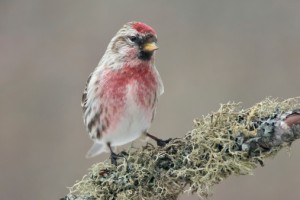 Winter is coming, whether we like it or not, and in the Adirondacks that usually means a lot of snow. Some people provide a winter haven for our feathered friends by way of a backyard bird feeder. Cardinals, Blue Jays and Chickadees are all very recognizable winter birds that frequently appear at feeders, but sometimes you might notice a small, finch-like bird donning a red forehead patch and a blushing chest. This is the Common Redpoll, but don’t let their diminutive size fool you – these highly intelligent birds are hardy winter survivors.
Winter is coming, whether we like it or not, and in the Adirondacks that usually means a lot of snow. Some people provide a winter haven for our feathered friends by way of a backyard bird feeder. Cardinals, Blue Jays and Chickadees are all very recognizable winter birds that frequently appear at feeders, but sometimes you might notice a small, finch-like bird donning a red forehead patch and a blushing chest. This is the Common Redpoll, but don’t let their diminutive size fool you – these highly intelligent birds are hardy winter survivors.
According to the Cornell Lab of Ornithology, the Common Redpoll is an energetic member of the finch family. As active foragers, these little birds travel in flocks and mostly eat small seeds. Though they prefer tree seeds, the also are known to consume grass and flower seeds. Occasionally they consume berries, and in the summer they bulk up on protein by enjoying spiders and insects. During the winter months, they eat mainly birch and alder seeds. They enjoy stopping by the feeder, too, for millet, thistle and nyjer seed.
What’s interesting is the Common Redpoll’s hardiness in chilly temperatures. These birds bulk up on their plumage in the fall in order to develop a warming layer for winter. Inhabitants of the arctic boreal forest, the Common Redpoll is able to withstand temperatures of -65ºF. Some even tunnel into the snow for warmth in the winter, digging tunnels that are more than a foot long and four inches under the snow. And if you think that’s surprisingly smart bird behavior – you’d be right! The Common Redpoll is as bright as its red forehead!
According to Cornell, animal behaviorists test an animal’s intelligence by observing whether it can pull a string to get a piece of food. The Common Redpoll passes this test with flying colors (no pun intended.) And, observers have witnessed the bird shaking seeds out of birch catkins, then dropping down to pick them up off of the snow. Not only is this bird smart, the Common Redpoll is also a world traveler. One bird was banded in Michigan and was later found in Siberia, birds from Alaska have been found on the East Coast of the U.S., and one Redpoll banded in Belgium was found in China!
Fortunately, we’ll be able to enjoy bird-watching for this little, energetic finch for years to come. Common Redpolls are numerous, and are listed as a species of least concern with the International Union for Conservation of Nature. So you have a great chance of catching this little red-capped avian at your feeder this winter – just don’t forget the millet, thistle and nyjer!
If you’d like to feed your fine-feathered Adirondack friends this winter, don’t forget to stock up on the birdseed you need to fill your feeder at Charlie Johns. We have a wild bird food selection that’s sure to bring myriad birds to your feeder all winter long. And while you’re there, don’t forget to stock up on food for your family and pets, too!